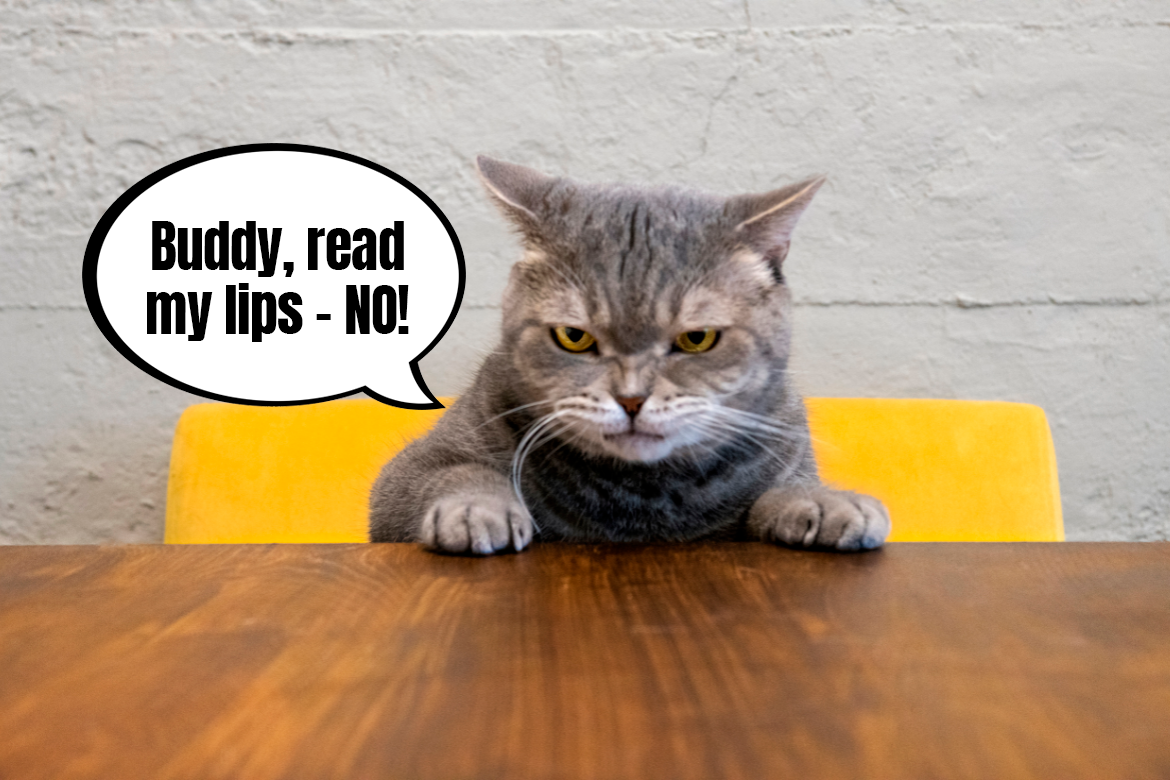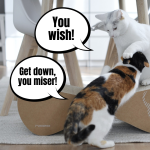Cats’ abilities regarding their body language never cease to amaze us. Moving their tails, whiskers and ears, making big eyes or squinting – everything has a meaning and cats, even if they don’t know each other, can easily talk to each other without making a sound. In a perfect world, we, their fabCat Carers, would also be able to easily read our cats’ body language and recognise the warning signs they’re sending our way without blinking an eye. But what if we could make that perfect world a little bit more real? Today, dear fabCats, we’re building a small dictionary of the feline sign language. Ready to learn some “STOP” signs, the cat version?
“Something’s not right here – be careful, or I’ll get angry”
As a warm-up, let’s start with a frequently used and quite direct signal which, in our opinion, should be recognised not just by cat Carers, but anyone who comes in contact with cats. It’s a cat dictionary basic – a simple message which, depending on the situation, can take different meanings. Of course, we’re talking about…
Moving tails. As far as cats are concerned, moving their tail is not a sign of happiness – contrary to their dog buddies who wag their tails when they’re content, a cat’s tail moves much slower, with more intention, often hitting it against the ground, starting slow and increasing the strength as they go. Such tail work is the first, clear signal that a cat might be agitated and overstimulated. When your cat starts moving the tip of the tail and increasingly speeding it up, all the way to a hit comparable to you hitting the table with your fist – drop the pets and let your cat calm down on their own terms.
Tail moves can also happen when a cat is annoyed by another cat (e.g. during play, when one of the participants clearly had enough), when we’re doing basic grooming procedures (e.g. brushing), but also when a cat is bored and can’t get our attention. It’s a universal sign that says “something’s not right here – be careful, or I’ll get angry”. Our own Kitku Yoda, for example, always reacts with a heavy tail beating when his buddy, Teddy, sneaks up on him from behind when Yoda is eating. It’s a warning sign you just can’t miss 🙂 – nasz teamowy Kitku Yoda reaguje mocnym „biciem” ogonem o podłogę, kiedy jego kumpel Teddy podchodzi do niego od tyłu, jak Yoda je. No nie da się tego ostrzegawczego sygnału przeoczyć:)
More on cat-hooman and cat-cat communication in one of our previous, popular articles on the blog:
Hypersensitive to touch
Cats can be the kings of drama and react intensely to what’s going on around them (Kitku Yoda is the best example of this – he even got a nickname “Primadonna”). This is why sometimes they run away if we unexpectedly get up off the couch or start hissing if something scares them. But nothing beats the drama they show when they don’t want our affection.
Do you know the skin twitching effect? Something that looks like your cat got shivers all over their body? It’s often a reaction to being overstimulated from being touched. A highly sensitive cat skin makes cats enjoy being pet at first and then quickly being annoyed by it. An annoyed cat can quickly jump off your lap and start to nervously clean the spot you were just touching or, if you don’t stop touching them, turn to pawicuffs and make use of their purrfecly sharpened pawdicure. If push comes to shove, even teeth can come out to play. Twitching skin is just a prelude to the trouble ahead.
When a cat is stressed
Feline body language can be used not just for direct contact with us and trying to say “Let go, I want to have some peace and quiet”. Many signals that cats send our way can also refer to how they are feeling at the moment – with the help of their ears, whiskers, tails or eyes, our furs can be trying to tell us that they’re bored, stressed out or in pain. It’s also a way of warning us – stress or boredom can escalate and turn from a simple “I have nothing to do” to a full on “pay attention to me or I’ll rip this couch into pieces”. This is why it’s good to put our scratchers by the couch, haha …
But let’s get to the nitty gritty:
- Tense, flat ears. Cat ears can move independently in various directions. But when they’re tense and pulled back, it’s a clear sign that a cat is stressed and nervous, but also submissive or ready to get aggressive because of the stressful situation they’re in.
- Whiskers positioning. Similarly to the ears, cat whiskers are a means of communication. If they’re relaxed (and so is the entire face), there’s nothing to worry about. However, if the whiskers are pointing forwards, they can show a cat being interested or slightly irritated by something. Interpreting the whiskers positioning on its own is harder than it is for ears, but once we look at the head as a whole, we’ll definitely know what’s going on.
- Dilated pupils. They can show real curiosity, if paired with a relaxed face and clear interest in something, but if a cat is laying their ears flat, tenses up and their pupils are dilated, it’s most probably a sign of fear and high stress levels. Symptoms like this can often be seen while you’re visiting the vet clinic, which is often a highly emotional event for most felines.
Some of the elements of cat communication were also mentioned in one of our previous, very interesting blog articles which we invite you, fabCats, to read as well:
Have you, dear fabCats, managed to master the hard task of talking to your furs with gestures and body language? Are any of the signs described today a frequent sight in your house?




